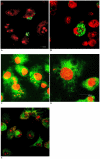The Trypanosoma cruzi protease cruzain mediates immune evasion
- PMID: 21909255
- PMCID: PMC3164631
- DOI: 10.1371/journal.ppat.1002139
The Trypanosoma cruzi protease cruzain mediates immune evasion
Abstract
Trypanosoma cruzi is the causative agent of Chagas' disease. Novel chemotherapy with the drug K11777 targets the major cysteine protease cruzain and disrupts amastigote intracellular development. Nevertheless, the biological role of the protease in infection and pathogenesis remains unclear as cruzain gene knockout failed due to genetic redundancy. A role for the T. cruzi cysteine protease cruzain in immune evasion was elucidated in a comparative study of parental wild type- and cruzain-deficient parasites. Wild type T. cruzi did not activate host macrophages during early infection (<60 min) and no increase in ∼P iκB was detected. The signaling factor NF-κB P65 colocalized with cruzain on the cell surface of intracellular wild type parasites, and was proteolytically cleaved. No significant IL-12 expression occurred in macrophages infected with wild type T. cruzi and treated with LPS and BFA, confirming impairment of macrophage activation pathways. In contrast, cruzain-deficient parasites induced macrophage activation, detectable iκB phosphorylation, and nuclear NF-κB P65 localization. These parasites were unable to develop intracellularly and survive within macrophages. IL 12 expression levels in macrophages infected with cruzain-deficient T. cruzi were comparable to LPS activated controls. Thus cruzain hinders macrophage activation during the early (<60 min) stages of infection, by interruption of the NF-κB P65 mediated signaling pathway. These early events allow T. cruzi survival and replication, and may lead to the spread of infection in acute Chagas' disease.
Conflict of interest statement
The authors have declared that no competing interests exist.
Figures








Similar articles
-
In vitro and in vivo studies of the trypanocidal properties of WRR-483 against Trypanosoma cruzi.PLoS Negl Trop Dis. 2010 Sep 14;4(9):e825. doi: 10.1371/journal.pntd.0000825. PLoS Negl Trop Dis. 2010. PMID: 20856868 Free PMC article.
-
Synthesis of macrocyclic trypanosomal cysteine protease inhibitors.Bioorg Med Chem Lett. 2008 Nov 15;18(22):5860-3. doi: 10.1016/j.bmcl.2008.06.012. Epub 2008 Jun 10. Bioorg Med Chem Lett. 2008. PMID: 18585034 Free PMC article.
-
Cysteine protease inhibitors alter Golgi complex ultrastructure and function in Trypanosoma cruzi.J Cell Sci. 1998 Mar;111 ( Pt 5):597-606. doi: 10.1242/jcs.111.5.597. J Cell Sci. 1998. PMID: 9454733
-
Cruzain : the path from target validation to the clinic.Adv Exp Med Biol. 2011;712:100-15. doi: 10.1007/978-1-4419-8414-2_7. Adv Exp Med Biol. 2011. PMID: 21660661 Review.
-
Computational approaches towards the discovery and optimisation of cruzain inhibitors.Mem Inst Oswaldo Cruz. 2022 Mar 16;117:e210385. doi: 10.1590/0074-02760210385. eCollection 2022. Mem Inst Oswaldo Cruz. 2022. PMID: 35293427 Free PMC article. Review.
Cited by
-
Trypanosomatid Infections: How Do Parasites and Their Excreted-Secreted Factors Modulate the Inducible Metabolism of l-Arginine in Macrophages?Front Immunol. 2018 Apr 20;9:778. doi: 10.3389/fimmu.2018.00778. eCollection 2018. Front Immunol. 2018. PMID: 29731753 Free PMC article. Review.
-
Peptidomimetic Vinyl Heterocyclic Inhibitors of Cruzain Effect Antitrypanosomal Activity.J Med Chem. 2020 Mar 26;63(6):3298-3316. doi: 10.1021/acs.jmedchem.9b02078. Epub 2020 Mar 17. J Med Chem. 2020. PMID: 32125159 Free PMC article.
-
The genome of the myxosporean Thelohanellus kitauei shows adaptations to nutrient acquisition within its fish host.Genome Biol Evol. 2014 Nov 8;6(12):3182-98. doi: 10.1093/gbe/evu247. Genome Biol Evol. 2014. PMID: 25381665 Free PMC article.
-
Novel cruzain inhibitors for the treatment of Chagas' disease.Chem Biol Drug Des. 2012 Sep;80(3):398-405. doi: 10.1111/j.1747-0285.2012.01416.x. Epub 2012 Jun 27. Chem Biol Drug Des. 2012. PMID: 22613098 Free PMC article.
-
Evasion and Immuno-Endocrine Regulation in Parasite Infection: Two Sides of the Same Coin in Chagas Disease?Front Microbiol. 2016 May 23;7:704. doi: 10.3389/fmicb.2016.00704. eCollection 2016. Front Microbiol. 2016. PMID: 27242726 Free PMC article. Review.
References
-
- Urbina JA. Specific chemotherapy of Chagas disease: relevance, current limitations and new approaches. Acta Trop. 2010;115:55–68. - PubMed
-
- Chagas C. Coletanea de Trabalhos Cientificos 1909-1913. Editora Universidade de Brasilia. 1982:237–335.
-
- Schuster JP, Schaub GA. Trypanosoma cruzi: skin-penetration kinetics of vector derived metacyclic trypomastigotes. Int J Parasitol. 2000;30:1475–1479. - PubMed
Publication types
MeSH terms
Substances
Grants and funding
LinkOut - more resources
Full Text Sources

